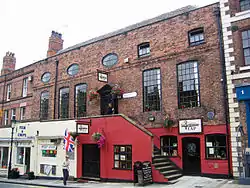Francis Gamull
Sir Francis Gamull, 1st Baronet (1606–1654) was an English politician who sat in the House of Commons from 1640 to 1644. He supported the Royalist side in the English Civil War and was active in the defence of Chester.
Gamull was the son of Thomas Gamull.[1] The family was of Buerton, Chester[2] He entered Inner Temple in November 1622.[1] In 1634 he became mayor of Chester. He was elected member of parliament for City of Chester for the Long Parliament in November 1640.[3]
During the Civil War, Gamull was very active in the defence of Chester. In June 1643 he established a town guard, of which he was colonel, and enlisted all able-bodied men between 16 and 60. After the governor, Sir Nicholas Byron, was captured in March 1644, King Charles proposed Gamull in his place, but Gamull was rejected because he was unpopular with the citizens and opposed by other royalist leaders. Gamull was disabled from sitting in parliament on 22 January 1644, but was created in the baronet of Chester in April 1644. He was nominated as mayor in 1644 but was rejected. By April 1645 there were signs of popular antagonism towards Gamull and his Welsh soldiers, as conditions under the siege became increasingly difficult. Gamull entertained King Charles at town house in Chester and was with him on the Phoenix Tower when they watched the defeat of the Royalist army at the Battle of Rowton Heath.[4]


After the siege was ended Gamull and other Royalists were dismissed from the town's administration in October 1646, and he was fined £940.[5] Gamull died at the age of 48 after an abortive uprising for the future Charles II. His son-in-law stated that he was executed at Exeter.[6] The Parish Register of St. Mary-on-the-Hill in Chester states that he was buried there on 27 November 1654.[7]
Gamull married, as his first wife, Christian Grosvenor daughter of Sir Richard Grosvenor, 1st Baronet in 1621. They had two daughters, and the baronetcy became extinct on his death.[2]
References
- Students admitted to the Inner Temple 1571–1625
- 'Bucknall – Buildwas', A Topographical Dictionary of England (1848), pp. 424–428. Date accessed: 4 June 2011
- Willis, Browne (1750). Notitia Parliamentaria, Part II: A Series or Lists of the Representatives in the several Parliaments held from the Reformation 1541, to the Restoration 1660 ... London. pp. 229–239.
- John Burke A genealogical and heraldic History of the Commoners of Great Britain
- 'Early modern Chester 1550–1762: The civil war and interregnum, 1642–60', A History of the County of Chester: Volume 5 part 1: The City of Chester: General History and Topography (2003), pp. 115–125. Date accessed: 4 June 2011
- 'Petition of Thomas Weston M.A. 4 August 1660'; Calendars of State Papers Domestic: Volume X: p. 179. British National Archives
- folio 85 in the year 1654: "Sr Francis Gamull buied in his own vault 27th November"